|
|
Canku Ota |
|
|
(Many Paths) |
||
|
An Online Newsletter Celebrating Native America |
||
|
November 30, 2002 - Issue 75 |
||
|
|
||
|
Eagle and Red Tailed Hawk |
||
|
|
|
Eagle wanted to know after all these years why was he sorry for them. "Well" said Red Tail, "When I saw Creator he told me how you had prayed to him every night that I would stop the contests and the foolish games. It made me feel so small in character, that I began to shrink to the size you see me now. Then Creator said as my punishment I would stay this way, and all my decedents shall be this size as well. And I will never be able to fly as high as the Eagle again. So my friend I truly am sorry for being so cruel to you. You clearly were better than me."
So on this they agreed, and cemented the friendship by giving each other a feather. And that is why Red Tail is smaller than Eagle. And why they both wear white as a sign of their continuing respect for each other. Print
and Color Your Own Red-Tailed Hawk |
|
|
|
Red Tailed Hawk
(Buteo jamaicensis)
|
|
The red-tailed hawk averages 19 to 24 inches in length. There is sexual dimorphism in size: females are 25% larger than the males. Plumage ranges from light auburn to deep brown. The underbelly is distinctly lighter than the rest of the body, with a dark belly band across it. The cere, the soft skin at the base of the beak, the legs, and the feet are all yellow. The eye color of the hawk changes from yellowish gray when immature to dark brown in adults. Food
Habits Reproduction The nests are usually 28 to 38 inches in diameter. They are sometimes used year after year and can be up to 3 feet tall. Both birds construct the nest using deciduous trees approximately 4 to 21 m above the ground. The nests are constructed of twigs while the lining consists of pine needles and bark. Fresh bark, twigs, and pine needles are deposited into the nest throughout the year to keep the nest clean. Owls compete with the red-tails for nest sites. Each species is known to feed on the young of the other in order to take the nest site. One to five eggs are laid around the first week of April. The eggs are incubated for about 30 days. Both parents help to incubate the eggs. Males may bring food to the female while on the nest. The young hatch at intervals of 1 to 2 days. Parents have to rip food up for them initially, and later leave it in the nest. The yound are fledged around 45 days. Behavior Habitat Curious Facts
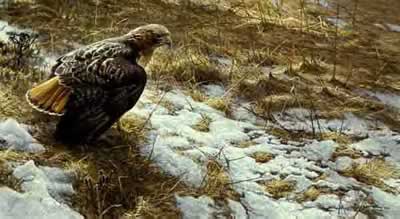 |
|
|
||
|
|
||
| Canku Ota is a free Newsletter celebrating Native America, its traditions and accomplishments . We do not provide subscriber or visitor names to anyone. Some articles presented in Canku Ota may contain copyright material. We have received appropriate permissions for republishing any articles. Material appearing here is distributed without profit or monetary gain to those who have expressed an interest. This is in accordance with Title 17 U.S.C. section 107. | ||
|
Canku Ota is a copyright © 2000, 2001, 2002 of Vicki Lockard and Paul Barry. |
||
 |
 |
|
|
The "Canku Ota - A Newsletter Celebrating Native America" web site and its design is the |
||
|
Copyright © 1999, 2000, 2001, 2002 of Paul C. Barry. |
||
|
All Rights Reserved. |
||
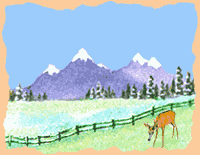 A
long time ago Eagle, and Red Tail were the same size, and very good
friends. But Red Tail was very jealous of Eagle, and thought he was
better than him. Red Tail would always make up contests for them to
do, so he could show up his friend. This really made Eagle very sad,
and every night he would pray to creator, that Red Tail would stop.
It was not that Eagle was inferior, just that competing with a friend
was wrong. They should enjoy being different, and what each other brought
to the friendship.
A
long time ago Eagle, and Red Tail were the same size, and very good
friends. But Red Tail was very jealous of Eagle, and thought he was
better than him. Red Tail would always make up contests for them to
do, so he could show up his friend. This really made Eagle very sad,
and every night he would pray to creator, that Red Tail would stop.
It was not that Eagle was inferior, just that competing with a friend
was wrong. They should enjoy being different, and what each other brought
to the friendship.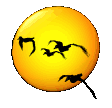 Well,
one day Red Tail came up with the idea, that they would each fly as
high as they could, and then soar back down to the ground. Eagle kept
saying he did not want to compete with his friend it was wrong. But
Red tail would not be put off. He kept taunting Eagle till he finally
gave in to him. They both took off, and started flying. Eagle was ahead
of Red Tail, and this made him furious. He started playing tricks on
Eagle acting like he was hurt. When Eagle came back to help him he took
off so fast, he lost some of his feathers.
Well,
one day Red Tail came up with the idea, that they would each fly as
high as they could, and then soar back down to the ground. Eagle kept
saying he did not want to compete with his friend it was wrong. But
Red tail would not be put off. He kept taunting Eagle till he finally
gave in to him. They both took off, and started flying. Eagle was ahead
of Red Tail, and this made him furious. He started playing tricks on
Eagle acting like he was hurt. When Eagle came back to help him he took
off so fast, he lost some of his feathers.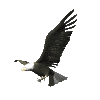 Eagle
decided to just let Red Tail win then maybe the contests would stop.
So Eagle just soared around waiting for Red Tail to come back. He soared
for 3 days waiting. He was beginning to really worry about his friend.
Finally he saw Red Tail coming back. But he looked really small to him.
As Red Tail got closer Eagle noticed that he was smaller. Eagle asked
him where had he been, and what had happened to him. Red Tail told him
he went so high he saw creator. Eagle thought he was playing a joke
on him. But Red Tail told him so seriously, that he was very sorry for
all the contests, and mean tricks he had played on him.
Eagle
decided to just let Red Tail win then maybe the contests would stop.
So Eagle just soared around waiting for Red Tail to come back. He soared
for 3 days waiting. He was beginning to really worry about his friend.
Finally he saw Red Tail coming back. But he looked really small to him.
As Red Tail got closer Eagle noticed that he was smaller. Eagle asked
him where had he been, and what had happened to him. Red Tail told him
he went so high he saw creator. Eagle thought he was playing a joke
on him. But Red Tail told him so seriously, that he was very sorry for
all the contests, and mean tricks he had played on him. Eagle
was so touched by Red Tails words all he could do was look at him. Then
he said to Red Tail, "No my friend we are equal yet different.
Unique in our own ways. You will always be my friend. But now we can
celebrate our differences, and our new understanding of each other."
Eagle
was so touched by Red Tails words all he could do was look at him. Then
he said to Red Tail, "No my friend we are equal yet different.
Unique in our own ways. You will always be my friend. But now we can
celebrate our differences, and our new understanding of each other."
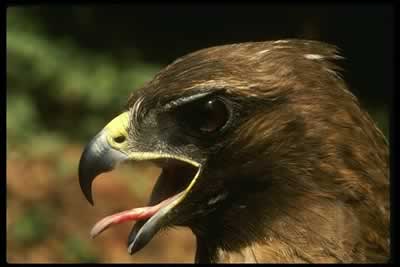 The
red-tailed hawk is found throughout the United States and Canada, into
Mexico and Central America. Many birds are year round occupants although
the birds of the far north will migrate south during the fall to escape
the harsh winter.
The
red-tailed hawk is found throughout the United States and Canada, into
Mexico and Central America. Many birds are year round occupants although
the birds of the far north will migrate south during the fall to escape
the harsh winter. 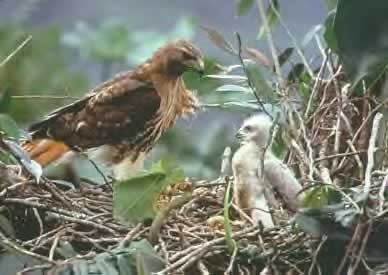 Red-tails
usually begin breeding when they are three years old. Red-tails tend
to be monogamous, only finding a new mate when theirs dies. A sure sign
of breeding in the spring is that the male and female perch in the same
tree to hunt. During courtship the birds soar near each other in circles
with flights lasting 10 minutes or more. Mating ususally takes place
following this.
Red-tails
usually begin breeding when they are three years old. Red-tails tend
to be monogamous, only finding a new mate when theirs dies. A sure sign
of breeding in the spring is that the male and female perch in the same
tree to hunt. During courtship the birds soar near each other in circles
with flights lasting 10 minutes or more. Mating ususally takes place
following this. 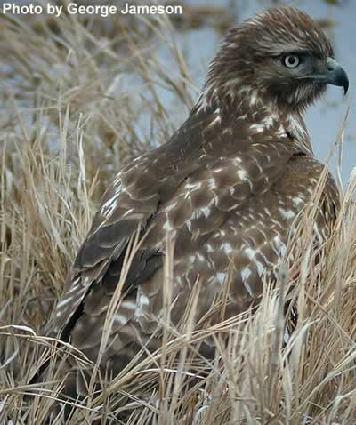 Red-tailed
pairs will remain together for years in the same territories. These
birds are very territorial. Their territories can range in size from
half a square mile to over 2 square miles depending on food, perches,
and nesting sites. The female is usually the more aggressive partner
around the nest itself, whereas the male is more aggressive when it
comes to the territory boundaries. The birds will soar over their territory,
mostly on clear days, looking for intruders. The red-tail has a series
of aerial behaviors. In the talon-drop, during courtship, they swoop
down trying to touch one another with their talons. Undulating-flight
is an up and down movement that is mainly used in territorial behavior.
Finally, in the dive-display the bird performs a steep dive. This is
also mainly used in territorial flights.
Red-tailed
pairs will remain together for years in the same territories. These
birds are very territorial. Their territories can range in size from
half a square mile to over 2 square miles depending on food, perches,
and nesting sites. The female is usually the more aggressive partner
around the nest itself, whereas the male is more aggressive when it
comes to the territory boundaries. The birds will soar over their territory,
mostly on clear days, looking for intruders. The red-tail has a series
of aerial behaviors. In the talon-drop, during courtship, they swoop
down trying to touch one another with their talons. Undulating-flight
is an up and down movement that is mainly used in territorial behavior.
Finally, in the dive-display the bird performs a steep dive. This is
also mainly used in territorial flights.